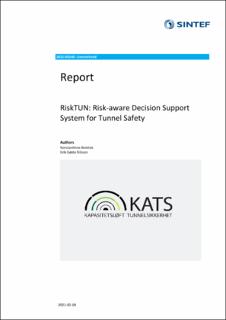| dc.description.abstract | Nowadays, technology can be a key tool to improve the effectiveness of emergency management and
human safety in road tunnels. The advantage of using decision support systems (DSSs) for emergency
management in complex situations is well known. These systems are mainly based on automated
processes in order to analyse the input coming from tunnel sensors and data and assist the tunnel
operator in making an informed decision in cases of emergency. Moreover, the importance of incident
prevention has been recognised. Incident prevention takes place through risk analysis, which has been
introduced as a way to calculate the probability for events with a large number of fatalities or material
damage to occur in a tunnel. The majority of current road tunnel risk analysis assess physical aspects
of the tunnel system and consider several hazards concerning the transportation of dangerous goods
through a tunnel.
In this work, we present a theoretical concept around the combination of emergency management and
incident prevention through risk analysis in DSSs. The proposed concept addresses the research
question “To what degree can we introduce risk analysis in a DSS system, combining it with its
emergency management functionality, and how?”. The ultimate goal is to provide a conceptualized
framework acting as a high-layer description and a guide for the design and implementation of risk aware DSSs that can be of further use by researchers and practitioners of the field.
RiskTUN is targeting a dual functionality: incident/accident prevention and emergency management.
RiskTUN is intended for use and facilitation of the stakeholders’ operation. These stakeholders that
are involved in tunnel emergencies are as following: i) tunnel operators, ii) emergency responders
(fire rescue service, ambulances, etc.), and iii) road users (e.g., passengers and drivers).
The RiskTUN DSS is basing its preventative operation on the collection of input data from the
available tunnel technologies/sensors, which are then analysed, and a risk grade is assigned to each
vehicle in the tunnel. If the grade is beyond a certain threshold a suggestion for action along with an
explanation as to why this suggestion is made, is sent from the system to the operator. Then, the
operator can make a decision so that an accident is prevented and inform the road users, emergency
responders (if needed), as well as use tunnel's emergency equipment. The same process is followed
for the emergency management functionality; however, the risk grade is only used for secondary
accidents, e.g., multiple car collision. The indoor positioning system of RiskTUN (mobile
application), the RiskTUN navigational mobile application for emergency responders, key
performance indicators for tunnel road safety, multi-attribute decision-making (DEXi) models, and
sketches of the DSS's user interface are presented and discussed, among others.
ISBN: 978-82-14-07688-2 | en_US |
